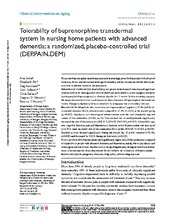| dc.contributor.author | Erdal, Ane | en_US |
| dc.contributor.author | Flo, Elisabeth | en_US |
| dc.contributor.author | Aarsland, Dag | en_US |
| dc.contributor.author | Selbæk, Geir | en_US |
| dc.contributor.author | Ballard, Clive | en_US |
| dc.contributor.author | Slettebø, Dagrun Daltveit | en_US |
| dc.contributor.author | Husebø, Bettina | en_US |
| dc.date.accessioned | 2019-06-28T08:29:45Z | |
| dc.date.available | 2019-06-28T08:29:45Z | |
| dc.date.issued | 2018-05-16 | |
| dc.Published | Erdal A, Flo E, Aarsland D, Selbæk GS, Ballard C, Slettebø DD, Husebø BS. Tolerability of buprenorphine transdermal system in nursing home patients with advanced dementia: a randomized, placebo-controlled trial (DEP.PAIN.DEM). Clinical Interventions in Aging. 2018;13:935-946 | eng |
| dc.identifier.issn | 1178-1998 | |
| dc.identifier.uri | https://hdl.handle.net/1956/20507 | |
| dc.description.abstract | Purpose: Buprenorphine transdermal system is increasingly prescribed in people with advanced dementia, but no clinical trial has investigated the safety and factors associated with discontinuation due to adverse events in this population. Patients and methods: One hundred sixty-two people with advanced dementia and significant depression from 47 nursing homes were included and randomized to active analgesic treatment (acetaminophen/buprenorphine) or identical placebo for 13 weeks. In this secondary analysis, the main outcomes were time to and reasons for discontinuation of buprenorphine due to adverse events. Change in daytime activity as measured by actigraphy was a secondary outcome. Results: Of the 44 patients who received active buprenorphine 5 μg/hour, 52.3% (n=23) discontinued treatment due to adverse events compared to 13.3% (6 of 45) in the placebo group (p<0.001). Psychiatric and neurological adverse events were the most frequently reported causes of discontinuation (69.6%, n=16). Concomitant use of antidepressants significantly increased the risk of discontinuation (HR 23.2, 95% CI: 2.95–182, p=0.003). Adjusted for age, sex, cognitive function, pain and depression at baseline, active buprenorphine was associated with 24.0 times increased risk of discontinuation (Cox model, 95% CI: 2.45–235, p=0.006). Daytime activity dropped significantly during the second day of active treatment (-21.4%, p=0.005) and decreased by 12.9% during the first week (p=0.053). Conclusion: Active buprenorphine had significantly higher risk of discontinuation compared with placebo in people with advanced dementia and depression, mainly due to psychiatric and neurological adverse events. Daytime activity dropped significantly during the first week of treatment. Concomitant use of antidepressants further reduced the tolerability of buprenorphine. | en_US |
| dc.language.iso | eng | eng |
| dc.publisher | Dove Press | eng |
| dc.relation.uri | https://www.dovepress.com/tolerability-of-buprenorphine-transdermal-system-in-nursing-home-patie-peer-reviewed-article-CIA | |
| dc.rights | Attribution CC BY-NC | eng |
| dc.rights.uri | http://creativecommons.org/licenses/by-nc/3.0/ | eng |
| dc.subject | opioids | eng |
| dc.subject | analgesics | eng |
| dc.subject | Dementia | eng |
| dc.subject | drug safety | eng |
| dc.subject | adverse drug reactions | eng |
| dc.title | Tolerability of buprenorphine transdermal system in nursing home patients with advanced dementia: a randomized, placebo-controlled trial (DEP.PAIN.DEM) | en_US |
| dc.type | Peer reviewed | |
| dc.type | Journal article | |
| dc.date.updated | 2019-01-27T17:50:00Z | |
| dc.description.version | publishedVersion | en_US |
| dc.rights.holder | Copyright 2018 The Author(s) | |
| dc.identifier.doi | https://doi.org/10.2147/cia.s161052 | |
| dc.identifier.cristin | 1588787 | |
| dc.source.journal | Clinical Interventions in Aging | |

